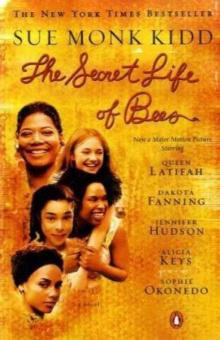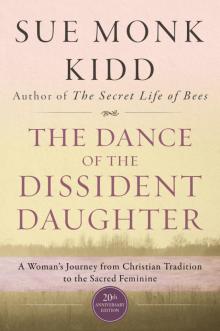- Home
- Sue Monk Kidd
The Dance of the Dissident Daughter Page 5
The Dance of the Dissident Daughter Read online
Page 5
At the time I had delusions that I was probably the only woman in the world with a wound like that. Later I would be surprised to discover that most women carry this wound, though it is usually buried and unnamed. Psychotherapist Anne Wilson Schaef’s name for this wound is “the original sin of being born female.” She writes,
To be born female in this culture means that you are born “tainted,” that there is something intrinsically wrong with you that you can never change, that your birthright is one of innate inferiority. I am not implying that this must remain so. I do believe that we must know this and understand it as a given before it can be worked through.14
Of course, being female is not inferior at all, but that doesn’t change the fact that women have often experienced it that way. Messages of inferiority and self-denial are passed to us all our lives, messages that we should deny our own experiences, feelings, and needs. We absorb them in an ongoing process of osmosis that creates and enlarges the wound’s core.
Early on a girl starts to soak up the idea that she is less than boys. Not long ago my friend Betty told me about the day she and her husband walked beside the rapids of the Chatooga River and came upon a young family. Betty watched as the father took the boy, who looked about four years old, down to the water’s edge so he could dip his hands into the surging water and feel the spray on his face. The boy’s sister, slightly older, begged her mother to take her to the edge, too. “No,” the mother told her. “It’s too dangerous there.”
A small incident, but when multiplied a hundred, a thousand times in a little girl’s life, she learns that she’s not as capable as a boy of handling life on the edge. She learns to hang back.
Peggy Orenstein’s 1994 book, Schoolgirls,15 draws on a 1991 survey by the American Association of University Women, which suggests that parents and teachers seem to have lesser expectations for girls than for boys. Orenstein showed that girls’ self-esteem is lost as they “dumb themselves down” and conform to lesser expectations to avoid being threatening. The girls in her study learned by adolescence not to be too outspoken, too aggressive, or too smart. They learned to balance drive with deference. The boys, by contrast, were rewarded for their drive and discouraged from showing deference. Girls learned to negate themselves through simple experiences: On the playground calling a boy “a girl” was the worst slur possible.
Orenstein also found that boys received more attention from teachers than did girls. In many of the classrooms she visited, boys were called on more often. Even at home many of the schoolgirls felt their brothers were favored, that the boys were, in fact, listened to more than they.
At church girls fare no better. A young girl learns Bible stories in which vital women are generally absent, in the background, or devoid of power. She learns that men go on quests, encounter God, and change history, while women support and wait for them. She hears sermons where traditional (nonthreatening) feminine roles are lifted up as God’s ideal. A girl is likely to see only a few women in the higher echelons of church power.
And what does a girl, who is forming her identity, do with all the scriptures admonishing women to submission and silence? Having them “explained away” as the product of an ancient time does not entirely erase her unease. She also experiences herself missing from pronouns in scripture, hymns, and prayers. And most of all, as long as God “himself” is exclusively male, she will experience the otherness, the lessness, of herself; all the pious talk in the world about females being equal to males will fail to compute in the deeper places inside her.
As a girl absorbs her culture, for instance as she watches movies and television, she may also come to understand that her real importance derives from her relationship with men and boys, by how good she looks for them or how well she takes care of them. She will notice the things traditionally assigned to women—keeping a home, cleaning, cooking, laundry, child rearing—and grow aware of how little value these things seem to have in the world compared to things men typically do.
When she grows up and enters the workplace, she will likely plunge into the staggering dilemma that is often hers alone—working while caring for children and keeping a house. She’ll likely encounter ceilings, networks, and traditional assumptions that work against her as a woman. She will arrive at the disconcerting realization that success comes only as she learns to modulate and adapt her feminine self to a man’s world.
If she sees few women in places of real power, hears few female voices of strength, and witnesses little female creativity, then despite what is said to her about women’s equality, she experiences women (and herself) as absent and silent.
The feminine wound is created as we internalize all these experiences—the voices we hear at church, school, home, work, and within the culture at large suggesting (in ways both bold and subtle) that women and feminine experience are “less than.”
If you receive often enough the message that women are inferior and secondary, you will soon believe you are inferior and secondary. As a matter of fact, many experts tell us that “all women in our society arrive at adulthood with significant feelings of inadequacy.”16
Once on an airplane I sat beside a thirty-year-old woman with a briefcase. As we chatted, a female voice came over the loudspeaker and said, “This is your captain.”
The woman stopped midsentence. “Oh no,” she said, “a woman pilot.”
“I’m sure she’s well trained,” I said.
“Right,” she said, “but she’s still a woman.”
Her feminine wound—her personal concentration of female inferiority—had made a brief appearance.
As time went on, I would grasp how deep such wounds go. For we carry not only our own wounding experiences, but the inherited wounds of our mothers and grandmothers as well. “We think back through our mothers and grandmothers, if we are women,” Virginia Woolf said.17
This statement is not mere poetry. We carry something ancient inside us, an aspect of the psyche that Carl Jung called the collective unconscious. Containing river beds of collective experience, the collective unconscious is the place where preexisting traces of ancestral experience are encoded.18 Thousands of years of feminine rejection reside there, and it can rise up to do a dark dance with our conscious beliefs.
I read a moving example of this interplay in physician Christiane Northrup’s book, Women’s Bodies, Women’s Wisdom. She recounted being in the delivery room countless times, hearing new mothers apologize to their husbands when the baby was not male. She described the experience as staggering to her. But, she writes,
When my own second daughter was born. I was shocked to hear those very words of apology come into my brain from the collective unconscious of the human race. I never said them out loud, and yet they were there in my head—completely unbidden. I realized then how old and ingrained is this rejection of the female by men and women alike.19
For Northrup, as for me, recognizing this wound in herself was a pivotal moment in her growth as a woman.
There’s always the danger, though, that as we open our eyes to the social, physical, psychological, and spiritual violence done to women throughout history, not to mention the wounding in our own personal histories, we will become paralyzed by a sense of victimization. For me, opening my eyes to the feminine wound was rather like getting hit by a stun gun. I felt knocked down by the force of it, and for a short while I didn’t get up. On some level, I felt overwhelmed by the depth of the feminine wound, which I was uncovering, not only in myself, but all around.
The danger of getting stuck in feelings of victimization is real, but nevertheless, recognizing the feminine wound is important because in the end it’s the only way we can stop being victims. We can’t change anything until we acknowledge the problem. I’d been an unconscious victim before my awakening began. Discovering the truth was waking me up to my victimization, but it was also making it possible for me to move beyond it.
Feminist writer Naomi Wolf has especially cautioned women not to
shape our identity as victims. Yet shaping our identity as victims is quite different from naming the truth of our victimization in order to work against it and live into our power. If women don’t document and protest the harm done to us, who will? As Wolf says, “Women are not natural victims, but they sure are victimized.”20
While holding onto the awareness, then, that we must not fall into shaping our identity as victims, we have to tell ourselves the “flat-out truth,” as my grandmother used to call it. And the flat-out truth is that we have come into a world, into a church or faith tradition, that for millennia has believed us inferior. It is a tradition permeated by an authoritarian attitude that devalues, diminishes, rejects, and limits women and the feminine.
But seeing such truth can be dangerous. Philosopher Mary Daly reminds us, “It isn’t prudent for women to see all of this. Seeing means that everything changes: the old identifications and the old securities are gone.”21
The question, she says, is whether women can forgo prudence in favor of courage. That was the question that followed me as I made my way into the new year.
Winter of Resistance
I call the first winter of my awakening the winter of resistance. It was marked by persistent attempts to ignore the groundswell of pain and awareness that had erupted at the monastery and the new consciousness that wanted in.
One day I pulled the slender volume Children’s Letters to God from a bookshelf and came upon this letter from a little girl named Sylvia: “Dear God, Are boys better than girls, I know you are one but try to be fair. Sylvia.”22
Tears floated to my eyes. Why did questions like these inhabit little girls and grown women, and when did we lose our courage to confront God with them? I threw on a coat and left the house, hoping a walk would offer diversion. Outside it was cold and bright with winter sun. I walked to a neighborhood lake, sat on the grass, and watched a flotilla of ducks glide across the water in a perfect V.
I’d told no one about my experience at the monastery or the things it was kindling inside me. I wondered now if I should find someone trusted and pour out my experience. But did I really want to open up that hidden pocket of pain? Expressing it aloud to someone would hold me accountable to it in a whole new way, and frankly, I didn’t know yet if I wanted to own up to the wound I’d vividly uncovered.
Mostly, I didn’t want to believe I could have been wounded by my own faith. I didn’t want to acknowledge how it had relegated half the human population to secondary status and invisible places. I didn’t want any of this to be true.
The ground was starting to feel cold. Out on the lake, wind made scalloped patterns in the water. I drew my knees to my chin trying to muffle a throbbing space in my chest. I felt alone and unequipped for upheavals such as this. If I pursued this journey there would be so much to unravel, so much to unlearn.
Later I would read Ursula K. Le Guin’s comment: “I am a slow unlearner. But I love my unteachers.”23
I, too, was a slow unlearner. The problem was I didn’t have any unteachers. I didn’t personally know anyone close at hand who’d gone through a feminist spiritual awakening. How did one do it? Did I dare step over the boundaries church and convention had drawn for women? Did I dare venture beyond the place where my mother had stopped?
No, no, no.
I got up from the edge of the water and walked home. It was the prudence-or-courage question again. That day I chose prudence.
In the following weeks, I tried to ignore the monastery experience altogether, but as the days grew darker and the trees barer, it pushed unbidden into my thoughts. I could not seem to banish my awakening, so I did the next best thing. I trivialized it.
One of the primary forms that resistance takes is trivialization. Surely I was making a big deal out of this, I began to tell myself. So maybe there is a feminine wound in me, in women, in the church, in the earth, but what about all those other major problems I should be concerned about—the environment, crime, war, homelessness? What is a little feminine wound by comparison?
Yet the truth is, as long as one woman is dehumanized, none of us can be fully human.
Once during that time I abandoned prudence for courage. While at a party, the subject of women’s dedication to the church came up. “But for all our dedication, we’ve certainly gotten a rotten deal,” I said. It is the sort of thing waking women blurt almost without realizing it.
A man rolled his eyes at the ceiling. “Oh no,” he said. “You’re not one of those women, are you?”
“What women?” I asked.
“You know, those screaming feminists who are always yelling about how bad women have been treated.”
“No,” I told him fast as I could. “I’m not one of those.” And I dropped the subject as if it was toxic waste.
He had effectively dismissed my voice and experience. But then it hit me: Wasn’t that what I’d been doing to myself—dismissing my own experience, the voice speaking deep inside?
Trivializing our experience is a very old and shrewd way of controlling ourselves. We do it by censoring our expressions of truth or viewing them as inconsequential. We learned the technique from a culture that has practiced it like an art form.
The trick works like this. An image is created of a “screaming feminist” with an ax to grind. The image takes on enormous negative energy in the church and culture. Branding a woman with this image effectively belittles her opinion and discredits it. So rather than risk the image being attached to her, a woman will often back quickly away. I later realized that’s what I’d done when the man threatened to attach the label to me. It is a rare and strong woman who has enough inner substance to face the ridicule and pain that can come from expressing feminism.
The church itself has used this negative image as a way of controlling women and discouraging them from challenging the status quo. Once when I suggested to a woman that she stand up for women in a church situation, she said, “I really want to, but I’d hate to look like one of those fanatical feminists our minister preaches about.”
Sometimes, though, others’ attempts to control and trivialize don’t work. Once when I led a discussion at a mixed-gender retreat, a couple of women began to express their pain as women within Christianity. A male clergyman, who I suspect was feeling uncomfortable, said, “Oh, come on, the church is human, it makes mistakes. Why can’t you just forgive and be done with it?”
I’m not sure he realized what he’d done—brilliantly trivializing and dismissing their feelings. I mean, who could argue with what he said? Yes, the church is human. Yes, it makes mistakes. Yes, forgiveness is good.
There is a time to be gentle and a time to be fierce, and each of the two women managed to be both at the same time. Each spoke fierce things with a tone of gentleness. One said, “Must you focus on my need to forgive and let go? I’m not yet at a place where I can do that. I really need to express what’s inside me, and I need the church to listen. Why not go to the heart of it and focus on the church’s need to repent and change?”
The other woman said, “Think a moment. If men were at the bottom and women were the ones in charge, if our theology tended to give us the power and excluded you, if it deified the feminine only, would you still be saying, ‘The church is only human, why don’t you just let it go?’”
She brought to my mind the comment by Nelle Morton, one of the grandmothers of feminist spirituality, who said things are always different when you are looking “from the bottom up.” This looking from the bottom up is the catalyst for a reversal of consciousness, not only for ourselves but also for the most resistant among us. For when we stop perceiving, assuming, and theorizing from the top, the dominant view, and instead go to the bottom of the social pyramid and identify with those who are oppressed and disenfranchised, a whole new way of relating opens up. Until we look from the bottom up we have seen nothing.
Maybe that’s what happened to the man. Maybe the women’s gentleness opened his eyes and their fierceness forced him to perc
eive from the bottom up, because he was quiet for a while. Then he said, “I think I see what you mean.”
As the first spring of my awakening approached and I struggled to see, I grew less and less prudent. I would look at my daughter and think how I didn’t want her female life wounded. I didn’t want it wounded by the church or my own unconsciousness. Neither did I want my husband or my son to remain unconscious. And how would the cycle be broken, how would patterns be redeemed, if I kept resisting?
And I couldn’t help feeling a growing discontent with my female life, flashes of anger and sadness about the “way it is.” My attention was being drawn more and more to symptoms that cropped up inside me from time to time. I began to ask myself: Why do I sometimes feel tentative and self-doubtful? Why do I silence my real self? Why do I fall into driven and perfectionistic patterns? Why do I occasionally lapse into passivity, afraid to rock the boat? Why do I work so hard to fulfill outward expectations? Why does it matter that I please everyone? Are these things emanating from the feminine wound? And how can I keep ignoring them?
My dreams were full of earthquakes and floods. Old buildings crumbling and washing away. I was still reluctant to open myself up to the quaking and torrents inside, but the dream voice was telling me that whether I chose to recognize it or not, I was in the midst of upheaval. Something was toppling, and I’d better pay attention.
Dancing Women
In May I attended a Journey into Wholeness Conference on St. Simon Island off the coast of Georgia, a conference that explored the concepts of C. G. Jung. Toward the end of the conference week, around forty or fifty women decided to go to the beach and have something they were calling a full moon celebration. I don’t know what possessed me to go along. I suppose curiosity. Maybe some intuition that this was a moment to be seized, a now-or-never moment.
So I found myself following a long line of women winding through the sand dunes, walking by the light of a large moon suspended over the ocean. As the sound of the surf swelled in the distance, I felt the urge to turn back. But we’d all come together in several cars and a couple of vans; there was nothing to do now but get through it.

 The Secret Life of Bees
The Secret Life of Bees The Invention of Wings
The Invention of Wings Traveling With Pomegranates
Traveling With Pomegranates The Dance of the Dissident Daughter
The Dance of the Dissident Daughter The Mermaid Chair
The Mermaid Chair The Book of Longings
The Book of Longings The Invention of Wings: A Novel
The Invention of Wings: A Novel The Invention of Wings: With Notes
The Invention of Wings: With Notes